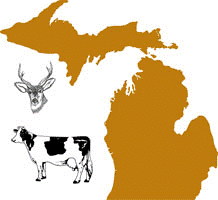Wildlife Disease and Zoonotics

Michigan Bovine Tuberculosis Bibliography and Database
Date of this Version
2007
Abstract
Wildlife reservoirs of Mycobacterium bovis represent serious obstacles to the eradication of tuberculosis in domestic livestock. In Michigan, USA tuberculous white-tailed deer transmit M. bovis to cattle. One approach in dealing with this wildlife reservoir is to vaccinate deer in order to interrupt the cycle of deer to deer and deer to cattle transmission. Thirty-one white-tailed deer were assigned to one of three groups; 2 SC doses of 107 CFU of M. bovis BCG (n = 11); 1 SC dose of 107 CFU of M. bovis BCG (n = 10); or unvaccinated deer (n = 10). After vaccination, deer were inoculated intratonsilarly with 300 CFU of virulent M. bovis. Gross lesion severity scores of the medial retropharyngeal lymph node were significantly reduced in deer receiving 2 doses of BCG compared to unvaccinated deer. Vaccinated deer had fewer lymph node granulomas than unvaccinated deer, and most notably, fewer late stage granulomas characterized by coalescent caseonecrotic granulomas containing numerous acid-fast bacilli. BCG was isolated from 7/21 vaccinated deer as long as 249 days after vaccination. In one case BCG was transmitted from a vaccinated deer to an unvaccinated deer. In white-tailed deer BCG provides measurable protection against challenge with virulent M. bovis. However, persistence of vaccine within tissues as well as shedding of BCG from vaccinates remain areas for further investigation.


Comments
Published in Vaccine 25 (2007) 6589–6597.